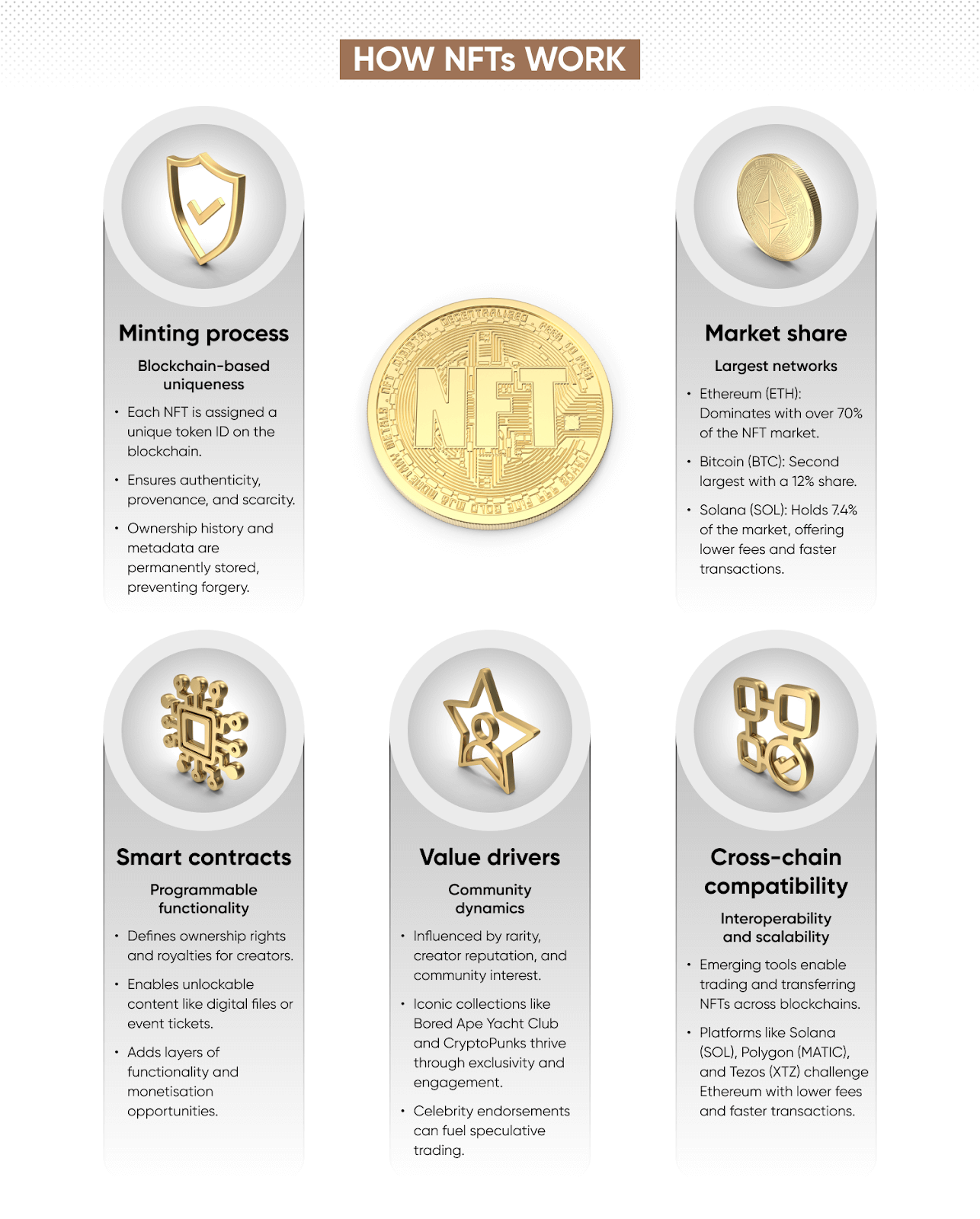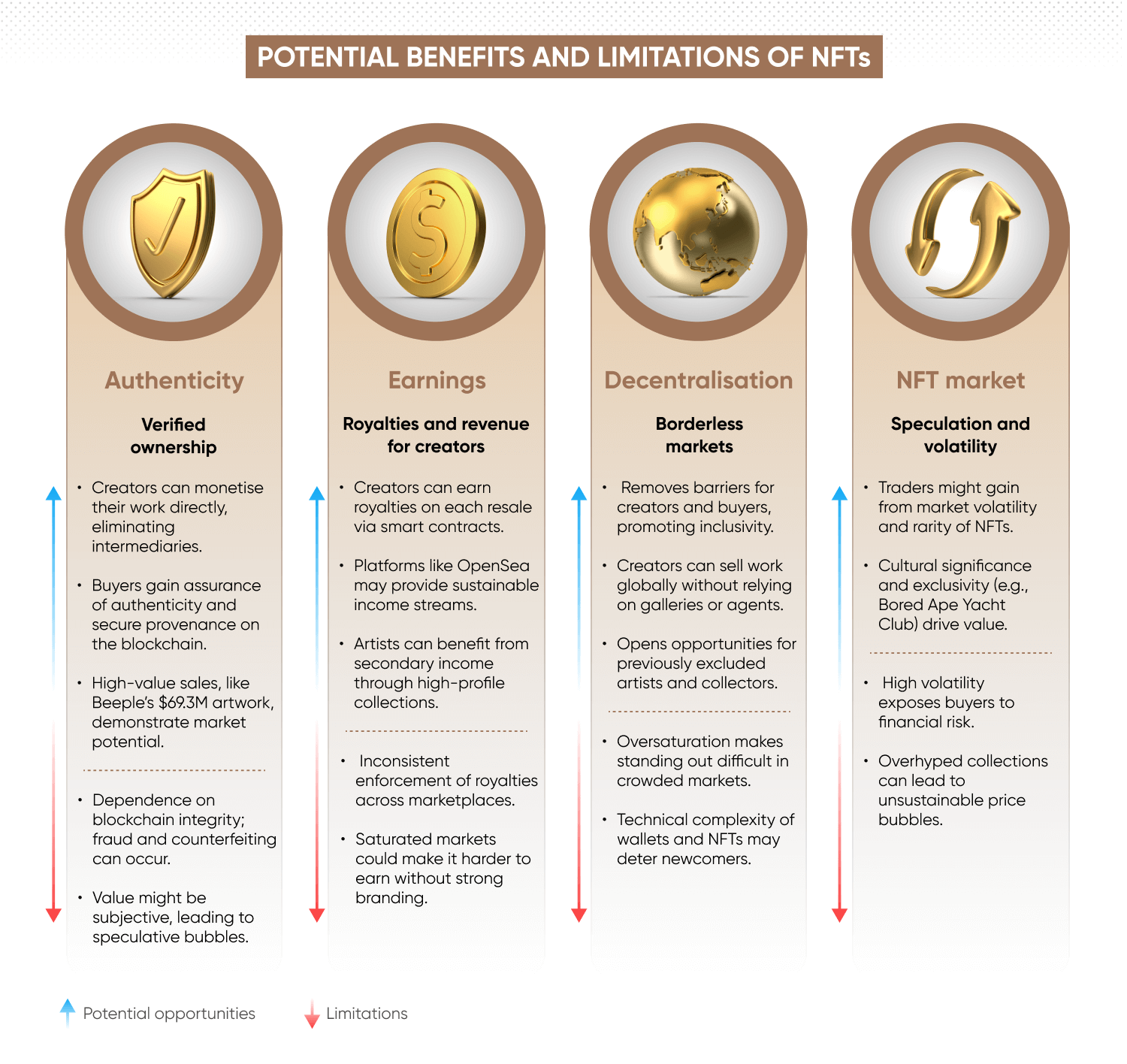What are NFTs and how do they work?

What is an NFT (non-fungible token)?
An NFT, or non-fungible token, is a unique digital asset that represents ownership or authenticity for a specific item or piece of content on the blockchain. Unlike cryptocurrencies like BTC or ETH – which are interchangeable, or ‘fungible’ – NFTs are one-of-a-kind and cannot be replaced on a like-for-like basis.
NFTs can represent a range of digital assets and even serve as links to physical items. Their value is driven by uniqueness, demand, utility, cultural significance, and the transparency of blockchain technology, which ensures publicly verifiable ownership and transaction history.
Today, NFTs have evolved into a multi-billion-dollar industry, with applications spanning art, collectibles, gaming, music, and entertainment.
How do NFTs work?
NFTs operate on blockchains, using the decentralised, transparent, and immutable natures of their underlying networks to mint unique digital assets. Each NFT is unique and identifiable via a unique token ID, while their attributes are determined by smart contracts. Like memecoins, NFTs’ value is heavily influenced by their communities, as well as the fundamentals of their parent blockchain.
Here’s how NFTs work and what shapes them:
Blockchain-backed uniqueness and provenance
Each NFT is minted on a blockchain and assigned a unique token ID, differentiating it from any other asset. This process ensures that NFTs are one-of-a-kind or part of a limited series, enabling their scarcity. Ownership history and metadata are permanently stored on the blockchain, providing transparency and preventing forgery.
Most NFTs are minted on one of three blockchains: Ethereum, Bitcoin, or Solana. Ethereum (ETH) is, by far, the most common blockchain for NFTs. According to February 2024 data, it holds over 70% of the market share. Bitcoin (BTC) is the second largest, with just over 12% market share. Solana (SOL) comes third, with 7.4% share of the NFT market.
Smart contracts and programmability
NFTs utilise smart contracts, self-executing code embedded on the blockchain, to define their attributes and govern their use. These contracts specify ownership rights, royalties for creators on secondary sales, and even unlockable content, such as exclusive digital files or event tickets. This programmability adds layers of functionality and monetisation opportunities to NFTs.
Community and market dynamics
The value of an NFT is influenced by factors like rarity, the reputation of the creator, and community interest.
Popular collections like Bored Ape Yacht Club and CryptoPunks have achieved cultural significance through a mix of exclusivity, celebrity endorsements, and active community engagement. These dynamics often lead to speculative trading, with some NFTs fetching millions at auction.
Cross-chain compatibility and scalability
Although Ethereum remains a leading platform for NFTs, other blockchains such as Solana (SOL), Polygon (MATIC), and Tezos (XTZ) are gaining traction, offering lower fees and faster transaction speeds. The emergence of cross-chain interoperability tools is expanding the ecosystem, with potential for users to trade and transfer NFTs across multiple networks.

What are the different types of NFT?
NFTs have become synonymous with digital ownership, offering a wide range of applications across various sectors. Here’s how some common types of NFTs compare:
|
Type |
Use cases |
Examples |
Key features |
|
Digital art |
Ownership of unique artworks. |
Beeple’s Everydays: The First 5000 Days. |
Value, scarcity, and provenance provided by blockchain. |
|
Collectibles |
Digital trading cards, memorabilia. |
NBA Top Shot, Cryptopunks |
Associated with pop culture or sports, with value tied to rarity and cultural appeal. |
|
Gaming assets |
In-game items that can be traded or sold. |
Axie Infinity, Decentraland |
Usable within games, tradable on secondary markets, and often key to gameplay. |
|
Music and media |
Exclusive content and fan experiences. |
Kings of Leon’s NFT album, Snoop Dogg NFTs |
Provides direct monetisation for creators, special access for fans; and opportunities for shared ownership or royalties. |
|
Virtual real estate |
Digital land ownership in virtual worlds. |
The Sandbox, Decentraland |
Allows users to build, trade, or monetise virtual spaces. |
As shown, intent and use cases can differ substantially from one token to the next, owing to the sheer variety of NFTs available.
NFTs: Potential benefits and limitations
If you decide to participate in the NFT market, consider the potential risks and opportunities involved. Here’s some of the key ones:
Ownership and authenticity
NFTs offer a revolutionary way to establish ownership and verify authenticity using blockchain technology.
Potential benefits – creators can monetise their work directly, eliminating the need for intermediaries. Buyers gain confidence in purchasing assets with ownership and provenance securely recorded on the blockchain. However, the authenticity of NFTs depends on the platform's verification systems. This has led to record-breaking sales, such as Beeple’s ‘Everydays’ artwork, which sold for $69.3 million through Christie’s auction house.
Potential limitations – NFTs rely heavily on the integrity of their underlying blockchain, and instances of fraud or counterfeiting still occur in platforms without stringent verification systems. Critics also argue that NFTs’ value is often subjective, making them prone to speculative bubbles.
Royalties and revenue for creators
NFTs enable creators to receive ongoing royalties through embedded smart contracts.
Potential benefits – unlike traditional sales models, NFTs allow creators to earn a percentage of revenue each time their work is resold. Platforms like OpenSea make it easy for artists and musicians to set royalty terms, creating a sustainable income stream. For example, some artists have earned substantial secondary income from high-profile NFT collections.
Potential limitations – while royalties are an attractive feature, royalty enforcement can be inconsistent, particularly when NFTs are sold across different marketplaces. Additionally, creators may face stiff competition in the saturated NFT market, limiting their earning potential without a strong personal brand or marketing effort.
Decentralised access and global reach
Operating on blockchain networks, NFTs remove traditional barriers to participation for both creators and buyers.
Potential benefits – NFTs democratise access to global markets, allowing creators from all over the world to sell their work without relying on galleries or agents. Buyers can participate in auctions or purchases from anywhere, promoting inclusivity. This has opened up opportunities for artists and collectors who were previously excluded from traditional art markets, though market saturation and visibility challenges remain.
Potential limitations – the accessibility of NFTs also invites challenges, such as oversaturation and difficulty standing out in a crowded market. Additionally, barriers such as high transaction fees, technical complexity, and limited internet access still exist.
Speculation and market volatility
The NFT market is heavily influenced by speculation and fluctuating demand.
Potential benefits – traders can capitalise on the market’s volatility, with some NFTs fetching millions in value due to their rarity or cultural significance. Collections like Bored Ape Yacht Club have demonstrated how community and exclusivity can drive immense value.
Potential limitations – high volatility and speculative trading expose buyers to significant financial risk. NFTs can lose value rapidly if market sentiment shifts, leaving some investors with losses. Moreover, overhyped collections can lead to unsustainable price bubbles.

Are there commercial opportunities with NFTs?
Many types of digital assets can be minted as NFTs, providing innovative ways for businesses to monetise and engage with customers. However, practical and legal considerations may limit what can be successfully minted.
Here are some examples:
Creating exclusive digital products
Businesses can mint unique digital items, such as branded virtual collectibles, digital art, or in-game assets, that customers can buy, sell, or trade. For example, Coca-Cola launched virtual NFT ‘loot boxes’ in 2021 as part of a charity auction. This initiative generated excitement among collectors while reinforcing its brand presence in the digital world.
Enhancing customer loyalty
NFTs have the potential to act as digital rewards or incentives, offering customers exclusive benefits like discounts, early access to products, or VIP experiences. These tokens foster engagement by creating a sense of exclusivity. For instance, some fashion brands have experimented with NFTs as digital equivalents of loyalty cards, granting special privileges to holders.
Building brand identity
When integrated into a thoughtful marketing strategy, NFTs can help certain companies stand out in competitive markets. Whether it’s a one-of-a-kind digital artwork or a limited-edition product, NFTs may increase brand visibility and attract tech-savvy audiences, though their effectiveness can depend on the specific market and audience.
FAQs
What does ‘minting’ an NFT mean?
Minting an NFT refers to the process of creating a unique digital token on a blockchain. This token certifies ownership or authenticity of a specific digital asset, such as digital art, music, or virtual real estate. During minting, metadata about the item – such as its creator, title, and any embedded royalties – is permanently recorded on the blockchain.
For example, artists often mint their digital works as NFTs to authenticate their creations and offer them for sale on platforms like OpenSea, Rarible, or similar marketplaces.
Do I need cryptocurrency to buy NFTs?
Yes, in most cases, purchasing NFTs requires cryptocurrency. ETH is the most commonly used, as the majority of NFT marketplaces operate on the Ethereum blockchain. Other cryptocurrencies like SOL, XTZ, or MATIC may also be accepted depending on the platform.
You’ll need to set up a crypto wallet, purchase the required cryptocurrency, and connect your wallet to an NFT marketplace to start buying. Some platforms now offer credit card payments.
What is an NFT art?
NFT art refers to unique digital artworks that are minted as non-fungible tokens (NFTs) on a blockchain. By using NFT technology, artists can create a digital certificate of ownership and authenticity for their works, ensuring they are one-of-a-kind or part of a limited series.
Visit our other complete guides

How to trade Bitcoin
